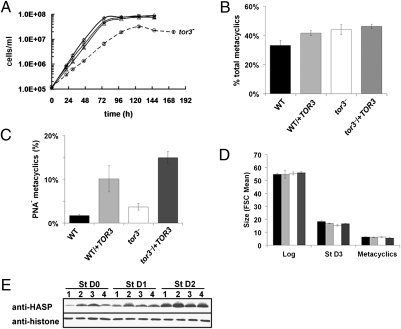Fig. 2.
L. major tor3− promastigotes have a slower-growth phenotype but do not show defective metacyclogenesis. (A) Growth of L. major promastigotes in vitro. WT (◇), WT/+MycTOR3 (□), tor3− (○), and tor3−/+MycTOR3 (Δ). Error bars show SE mean for two independent experiments. (B) Percentage of metacyclics in the total cell population on the second day of stationary phase (St D2) as determined by flow cytometry and gating for the smaller metacyclic vs. promastigote populations. Because tor3− grows more slowly and reaches stationary phase with a 1-d delay, St D2 occurs at 147 h for tor3− and 125 h for the other lines. Bars in Figs. 2–4 are shaded: WT, black; WT/+TOR3, gray; tor3−, white; and tor3−/+TOR3, darker gray. (C) Percentage of PNA- metacyclics, measured on St D2 as described above. (D) Size of promastigotes as measured by flow cytometry using the forward scatter (FSC) during logarithmic growth (Log), stationary phase (St D3), or of purified PNA− metacyclics (isolated on St D3). (E) Total cell lysates of promastigotes harvested upon entry or after 1 or 2 d in stationary phase (St D0,1,2) were analyzed by Western blotting with antisera to the metacyclic promastigote protein HASPB (28). Lanes are as follows: 1, WT; 2; WT/+TOR3; 3, tor3−; and 4, tor3−/+TOR3. Antihistone H2A antibodies were used as loading control.

